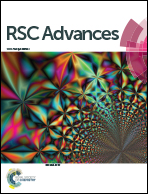Topological structure influences on the gel formation process and mechanical properties of l-lysine based supramolecular gels†
Abstract
The influence of a minor modification of the topological structure of a gelator’s core on the mechanism of the gel formation process and the resultant gel properties were researched by comparing the gelation ability of three L-lysine based gelators with the same arm structures and totally different topological core structures, one of which has a cubic topological polyhedral oligomeric silsesquioxane (POSS) core, one has a regular tetrahedron topological pentaerythritol core and the other has an organic linear topological dodecane core (denoted as POSS-Lys, PER-Lys and C12-Lys). Gelation tests, DSC, rheology measurements, SEM and POM investigations indicate that the gel obtained from C12-Lys with an organic linear topological dodecane core in the same solvent has a much greater strength of hydrogen bonding formed between the gelator molecules and much higher mechanical strength. What is more, POSS-Lys with a cubic topological core has a rather strong recovery ability, while PER-Lys cannot form a gel in any of the solvents tested. The key effect of such an obvious difference is in the self-assembly mechanisms which are influenced by the topological structure of the gelators.


 Please wait while we load your content...
Please wait while we load your content...